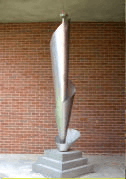Acroterion



An acroterion or acroterium or akroteria[1] is an architectural ornament placed on a flat base called the acroter or plinth, and mounted at the apex of the pediment of a building in the classical style. It may also be placed at the outer angles of the pediment; such acroteria are referred to as acroteria angularia (angulāria means ‘at the corners’).
The acroterion may take a wide variety of forms, such as a statue, tripod, disc, urn, palmette or some other sculpted feature. Acroteria are also found in Gothic architecture. They are sometimes incorporated into the design of furniture.[2]
The word comes from the Greek akrōtḗrion (ἀκρωτήριον ‘summit, extremity’), from the superlative form of the adjective akros (ἄκρος, ‘extreme, endmost’). It was Latinized by the Romans as acroterium.[3] Acroteria is the plural of both the original Greek[4] and the Latin form.[5]
According to Webb, during the Hellenistic period the winged victory or Nike figure was considered to be "the most appropriate motif for figured akoteria."[6]
See also
References
- ↑ p. 26-27
- ↑ http://www.britannica.com/EBchecked/topic/4232/acroterion
- ↑ "acroter". Oxford English Dictionary (3rd ed.). Oxford University Press. September 2005. (Subscription or UK public library membership required.)
- ↑ Greek Architecture glossary Archived September 8, 2006, at the Wayback Machine.
- ↑ Acroterium at A Dictionary of Greek and Roman Antiquities, 1875.
- ↑ Webb, Pamela A., Hellenistic Architectural Sculpture: Figural Motifs in Western Anatolia and the Aegean Islands, The University of Wisconsin Press, Madison Wisconsin, 1996 p.26
External links
| Wikimedia Commons has media related to Acroterion. |